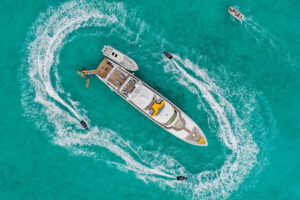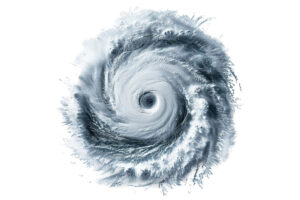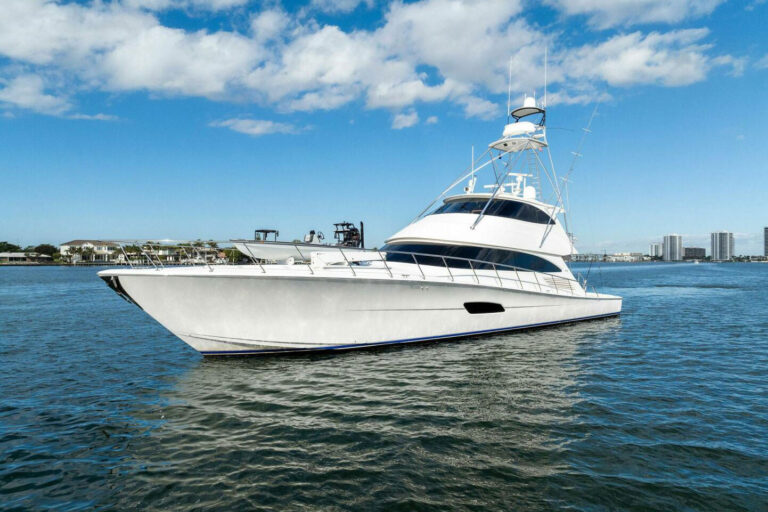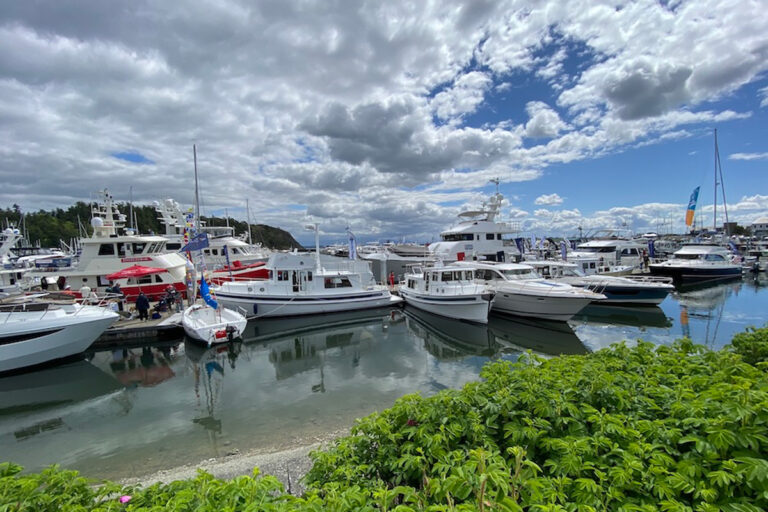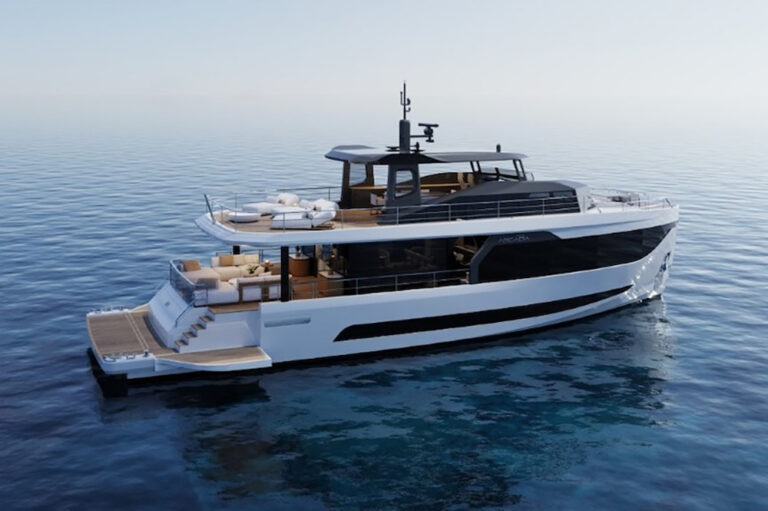
ytgjan26iceboats525.jpg
Imagine a sport that gives you just weeks of your life in which to measure glory. Yachtsmen have the America’s Cup, a heart-wrenching event which has challenged the likes of Turner and Conner, but for iceboaters, the season, not just the championship, can sometimes be little more than weeks depending on where they are in the country or frozen world. And unlike the sleek racing yachts that take in large sums from their sponsors to at least offset expenses, iceboaters put thousands into a vessel for a slim chance at a shimmering cup, a minimal monetary award, and individual immortality within a small yet fiercely competitive community. Yes, you’re the captain, flying along at windswept speeds that seem ungodly for a makeshift bladed boat skimming icecemented lakes. That doesn’t mean you wouldn’t cry out in alarm at the ragged crazing in nature’s glass-if only your cracked lips could purse well enough to form a four-letter scowl. But you know you signed on for this and now all you can do is steer-with your feet!
Meet Your Boat
Iceboats rely on three runner blades to minimize friction as you barrel across frozen water. Lines connecting to the boom allow the sail to be pulled to affect acceleration. A DN racer (named for the Detroit News, which sponsored the competition that led to its design) weighs around 50 pounds, is 12 feet long, and has very little protecting you from ice-kissed conditions. The better-known Skeeter weighs as much as 600 pounds, and is 30 feet long. Four-time International Skeeter Association World Champion Dan Clapp describes piloting it as: “sitting in a La-Z-Boy and feeling overheated, even when it’s just a few degrees above zero!” Other types of iceboats also exist, such as the Renegade, though its race results aren’t followed as closely. Europeans stick to the DN class, with some boats finding government sponsorship, though Americans are left to their own means, says Ron Sherry, a previous winner of the DN World Championship. “We definitely have a rivalry with the Europeans. But after the racing’s done, we party down with them like we’re best friends!” The most popular championship is DN World, sponsored in alternate years by North America and Europe, with the specific location determined based on conditions. Europe will host this year.
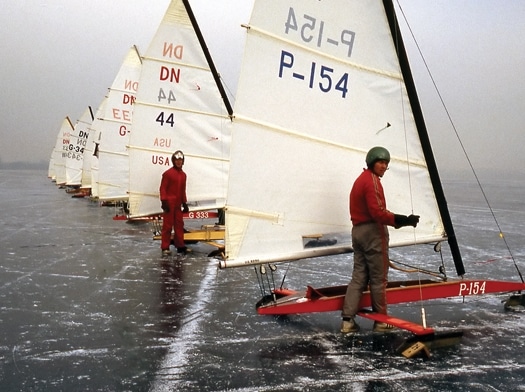
| | |
In an iceboat race, you run for several moments, then swing onto the plank, assuming a prone position on your back. You steer the often-three-mile course with your feet, working the sheets with both hands. Stuck in the lying position for much of the race, not unlike luge, you need to hold your neck up in order to see where you’re headed. An iceboat has no brake, and is streamlined by pulling the sail in, for speed, or letting the line out to make the sail fuller, reducing speed. Fast to begin with, friction is minimized because there is no hull. Though the lines need to be pulled hard at times, give it too much and you’ll lose the mast-and maybe more. “My lead on Tom Nichols was only two lengths in (a) championship race,” recalls Clapp. “I pulled with everything to get some distance, snapped my mast, and lost the world championship to him in the process.”
Iceboats date back to the 1600s, when they transported thousands of pounds of cargo across the frozen canals of the Netherlands. Today, they’re mostly for recreation, prevalent on the East Coast and in the upper Midwest of the United States. World Championships for the most popular American class of boat are held in March, as the season winds down, and often switch off from Lake Champlain in Vermont to Lake Geneva in Wisconsin.
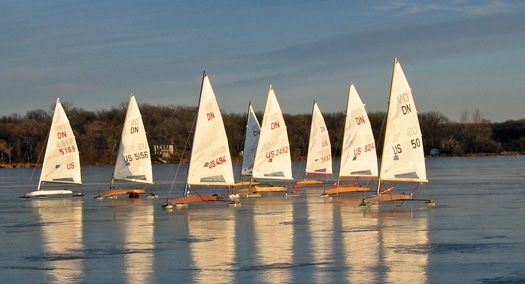
| | |
It’s not just the rush of sidesplitting speeds of up to 90 miles per hour, it’s the anticipation of rare competition that brings fellow racers together. “If there isn’t enough ice or the winds aren’t right, we have to wait it out,” says Tom Nichols, who’s won multiple ISA Skeeter World Championships. “It can be frustrating to call in to your boss and say you’re going to be a few days late because the race keeps getting postponed. But then when you finally get off and running, it’s a treat, because you know it didn’t come easy.” The length of the season ultimately depends on your willingness to travel and whether nature brings an unseasonably warm December and January. “I’m in the northern part of New Jersey ” Nichols says, “We’ve had poor winter conditions in the past, so sailing locally was zilch.” The only solution, according to Nichols, was to pack up and go to Upper Wisconsin, Upper Michigan, or Maine. Boaters will show up and, if the weather isn’t what they expected, will drive hundreds of miles, sometimes through treacherous conditions, in search of the perfect glide. If iceboaters sound like zealots, that’s because they often are. Nichols says many make major financial commitments, traveling all the way to Hungary’s Balaton, a 50-mile-long lake revered by many as the best racing venue anywhere.
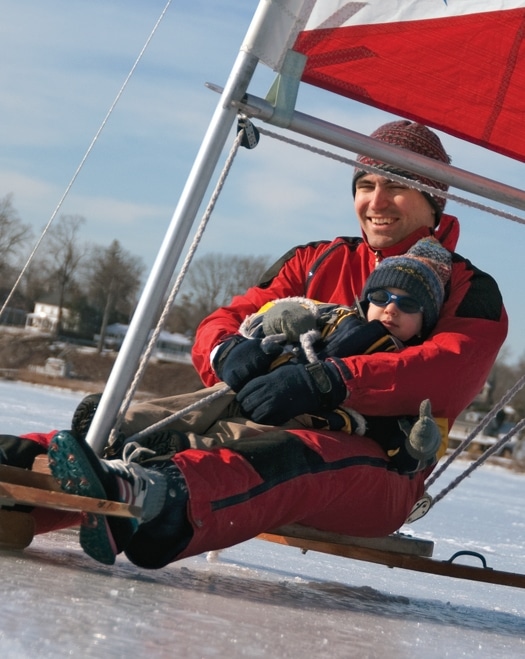
| | |
In fact, the starts and stops are the reason many racers won’t bother with corporate life, running their own businesses to accommodate the constant time off the short season demands. Sherry has grown his passion into a career designing iceboats. “It gets in you and becomes your way of life,” he says. “I just have to feel that feeling that racing gives me.” In Sherry and Clapp’s cases, that not may be their fault-iceboating is in their blood. Sherry’s father, Lorne, was a three-time world champion in the Renegade class and started building iceboats for his kids when Ron was nine years old. By the time Ron was 16, he was a Junior World Champion on Lake Champlain. For Clapp, it goes back to his grandfather. “I have pictures of a boat I sailed that was 100 years old that raced the trains on the Hudson River, my dad at five in the cockpit.” So you’ll have to forgive Don’s dad for sailing an iceboat at the regatta while his mother gave birth to him. Over time, Don has.
The Waiting Game
Nichols says the committee decides three to four days in advance where they can race. If they can’t boat once they get there, they’ll simply pick up a race at the closest possible spot with good conditions. Nichols says it makes for a reversal at home where it’s his son that complains Dad’s always on the phone and Internet, trying to predict the weather. In addition, local scouts, known as commodores, give firsthand accounts of weather in an attempt to make sure the racers have the best chance of catching perfect conditions. Nichols recalls a rush to meet at Lake Champlain in ’06, only to have unexpected snow result in a three-week delay before they could race.
Beyond the vagaries of weather come the intricacies of the race itself. As in sailing races, the most important rules deal with right of way- whether the racer who hit you is in the wrong or not, you can both be thrown out if you failed to avoid the collision through inattention.
The course is laid out in a fairly straightforward manner. The distance is two marks, one upwind, at the starting line, the other downwind, at the finish line. Marks are a mile apart, not less, but can be more than that. There are four laps in a race but if the course is shorter it will be five laps, three races qualifying it for regatta status.
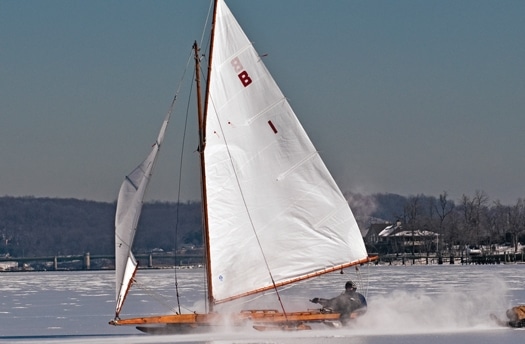
| | |
Claimed speed records get faster as time goes on, but Nichols is just a bit dubious. “Top speed some guys have is 144 miles per hour,” he says. “My boat is as fast as any and I’ve seen upper 80s to low 90s.” The surface plays into the wind, says Nichols, and the rule of thumb is that clean ice which is hard and smooth adds 5 miles per hour. He brings up terms that sound almost made up but clearly have been uttered by many a racer. Take “super rock hard ice” versus “decently smooth ice.” The first you avoid because of slipping and sliding, he says, and the other you crave as long as the runners don’t “bite into it.” But there’s also “snow ice” which is smooth and on the gray side. Nichols breaks it down even further: “Brand new ice or black or green ice, that’s good-if winds aren’t blowing too hard.” Bottom line, every kind of surface has its strengths and weaknesses and must be read properly to gain the necessary advantage for victory.
Considering the lure of top speeds, you would think iceboating has a bright future. Clapp isn’t so sure. The Internet and lifelike video games are keeping kids inside in the winter. But if you can get them on a boat come summer, he believes, maybe they’ll develop a yearlong itch that only a body of water-even a frozen one-can scratch.

